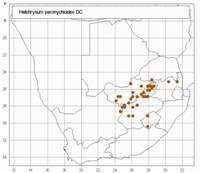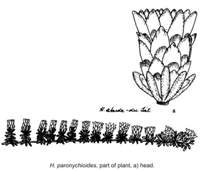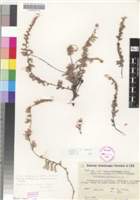Common names:
Poprosie (A)
Origin of name:
paronychioides = resembling the genus Paronychia (Caryophyllaceae), a prostrate mat-forming herb
Diagnostic characters:
Branches prostrate with numerous leaf clusters on short stalks, each bearing one headSmall needle-like leavesSolitary medium-sized headsBracts opaque white or pink, reflexed when older
Description:
Mat-forming subshrub, stock woody, up to 10 mm diam., main branches up to 300 mm long, many, prostrate, radiating from the crown, branching and giving rise to numerous very short (up to 5 mm) erect flowering branchlets, very closely felted, densely leafy, the whole forming a flowery mat. Leaves 3-8 x 0.5 (-1.75) mm, not diminishing in size upwards, imbricate, linear, acute, base broad, half-clasping, margins generally revolute, both surfaces closely enveloped in closely woven, silky grey tissue-paper-like indumentum, glandular as well, rarely woolly. Heads heterogamous, narrowly campanulate, c. 6 x 4 mm, sessile, solitary at the tips of the branchlets, these racemosely arranged. Involucral bracts in c. 6 series, graded, loosely imbricate, inner exceeding flowers, all radiating, semi-pellucid, glossy, outer white, inner rose-red, tips more or less opaque, subacute, mostly white. Receptacle shortly honeycombed. Flowers 19-31, 3-10 female, 12-25 homogamous, yellow, tipped pink. Achenes not seen, ovaries with myxogenic duplex hairs. Pappus bristles many, equaling corolla, scabridulous, bases cohering strongly by patent cilia.
Flowering between June and November, mainly August and September.
Distribution:
Grows in dry sandy open places. Ranges from Gauteng (Springbok Flats) through the Bushveld and Lowveld east to the southern part of Kruger National Park, south and west to the Northern Cape about Vryburg, Fourteen Streams and Hopetown, the dry parts of the Free State, and W. Lesotho. Also recorded from Lobatsi in SE. Botswana.
Grassland and Savanna Biomes.
Notes:
Sometimes confused with H. caespititium, but distinguished, among other characters, by its solitary heterogamous heads on very short lateral branchlets.
Taxonomy:
Literature:
Helichrysum paronychioides DC., Prodr. 6: 171 (1838); Harv. in F.C. 3: 216 (1865); Moeser in Bot. Jb. 44: 303 (1910).
Type:
Cape, beyond the Gariep [Orange], Pellat Plains, 10�28 August, Burchell 2234 (G-DC, holo. BOL; E; M; S, iso.).
Synonym(s):
Gnaphalium paronychioides (DC.) Sch. Bip. in Bot. Ztg 3: 169 (1845).
Vouchers:
Acocks 11715 (PRE); Fawkes 207 (NBG); Galpin 11560 (PRE); Martin 1021 (NBG); Pegler 931 (BOL).

